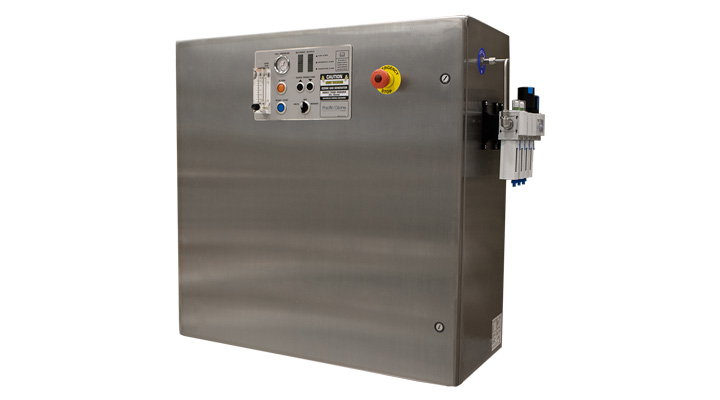In food processing, plant cleanliness is an absolute imperative. Product spillage and buildup on conveyors and machinery provide opportunities for the proliferation of spoilage organisms, which could contaminate the food products – costing millions of dollars in lost production. A major processor of tomato products implemented an ozone-based sanitation system to improve plant cleanliness and overall sanitation effectiveness with less effort and plant downtime for cleaning.

The Challenge:
Minimizing downtime while maintaining excellent plant sanitation and smooth operations are critical in processing fresh produce, such as tomatoes, which have a limited harvest season of approximately 100 days. With hundreds of tons of tomatoes arriving by truck daily, the plant needed every advantage to ensure cleanliness and keep it running like clockwork.
As traditional biocides simply retard microbial growth, periodic plant sanitization shutdowns are required since these biocides do not completely kill the bacteria. In attempt to improve the overall efficiency and cleanliness of the plant, the customer initiated a project to find ways to run the plant longer with less downtime for cleaning and sanitation without compromising cleanliness or food safety. The customer sought out a different way to meet their time-sensitive needs and requirements.
The Solution:
Assessment
The team began by assessing the effectiveness of existing processes by measuring lactate levels – an indicator of microbial growth – at each step of the process. Reduction in the concentrations of lactate indicates decreased growth of spoilage organisms. The initial testing and assessments allowed the team to identify and concentrate on the process points needing the most improvement.
Decision
After much consideration, the customer turned to ozone-based sanitation to keep the plant cleaner longer due to ozone’s efficacy in killing microbes. The lower the microbial load, the less often key equipment and processes need to be shut down for sanitation. Ozone sanitation allows the plant to produce more product with less effort and cost.
The Process
The customer opted to undergo a plant-wide process improvement program that included the application of ozonated water to replace chlorine dioxide in key cleaning processes. This multi-step project began with the application of ozone on part of one production line to allow the team to measure and compare the results of the improvements.
The team also implemented engineering changes to improve product flow of key process steps and replaced chlorine dioxide with ozonated water on the conveyor belts and on the central accumulation and distribution station. The ozone system delivered water with an applied dose of 2 parts per million (ppm) dissolved ozone to the spray bar nozzles placed at several locations along the conveyor system.
Early Success
The successes of the pilot program led to an expansion of ozone-based intervention within the plant. The team noted benefits including cleaner plant appearance, reduction of staining and product buildup on conveyor belts and other surfaces. Switching to ozone disinfection also improved the working environment and morale in the plant by reducing staining and spoilage odors.
By The Numbers
The Results:
Reduced Production Time
This pilot implementation resulted in a 37.5% reduction in lost production time due to line shutdown for clean in place. These impressive results convinced the team to expand the ozone project to deliver ozonated water to the rest of the distribution station.
System Optimization
A plant-wide ozone loop was designed and installed at the facility. The source water is fed to an integrated ozone system skid which is capable of delivering up to 3 ppm dissolved ozone at 175 gallons per minute (gpm) into a factory wide loop of spray bars and applicators. The system is optimized to compensate for losses in dissolved ozone due to decomposition within the loop and pressure drops across the spray heads. The ozone loop services spray bars on all major elevator and conveyor belt systems from the introduction of the tomatoes in the accumulation and distribution station to multiple peeling, processing, and filling lines. The entire system services over 100 spray nozzles.
The customer selected Pacific Ozone® PGS Peak powered by a Pacific Ozone GS ozone generator. The ozone generator produces up to 240 grams of ozone per hour (12.7 lbs./day), while ozone mass transfer is accomplished with venturi injection and 175 gallon 304L stainless steel reaction vessel. The system is monitored and controlled using a dissolved ozone analyzer and PID controller. Dissolved ozone monitoring can be expanded in the future to include multiple channels for additional monitoring points in the process. Ozone exposure and operator safety is ensured via an integrated ambient ozone detector that is safety interlocked with the system. Onboard ambient ozone detection is designed to shut down ozone production in the unlikely event of an ozone gas leakage. On the same line reduced production losses by 87.5%. Ozone also eliminates the costs of purchasing, storing, and handling hazardous chemicals. If the savings and production increases from ozone are applied across the entire plant, the break-even time with the ozone system will occur in just one harvest season.
Improved Smell
The qualitative benefits of ozone on the production lines that utilize ozone are obvious. In addition to the obvious cleanliness difference on the ozone-treated lines, these areas of the plant also benefited from less slime buildup and a better smell as well.


